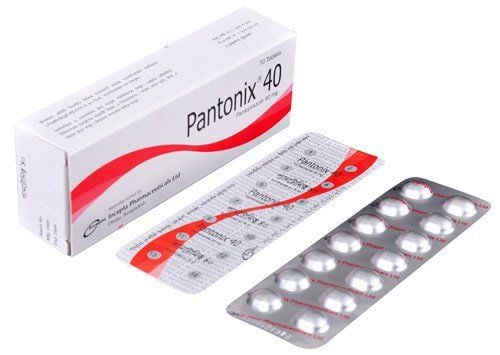This is an automatically translated article.
Each Pantin 40 tablet contains 40mg of pantoprazole as pantoprazol sodium sesquihydrate. Active ingredient pantoprazole is a proton pump inhibitor, indicated for the treatment of diseases in the gastrointestinal tract such as gastroesophageal reflux disease, Zollinger-Ellison syndrome...
1. What is Pantin 40?
Pantin 40 contains the active ingredient pantoprazole 40mg, which is a proton pump inhibitor that reduces the amount of acid produced in the stomach. Pantin 40mg is used to treat ulcerative esophagitis (damage to the esophagus caused by stomach acid caused by gastroesophageal reflux disease, or GERD), Zollinger-Ellison syndrome, and other conditions associated with excess stomach acid. excess stomach acid.
2. Uses of Pantin 40
Pantin 40 mg is indicated for use in adults and adolescents 12 years of age and older in the following cases:
Reflux esophagitis. In combination with antibiotics in the treatment of patients with ulcers caused by H. pylori . Stomach and duodenal ulcers. Pathological hypersecretory conditions and Zollinger-Ellison syndrome.
3. How to use Pantin 40mg?
Take Pantin exactly as prescribed by your doctor and pharmacist. Use the lowest therapeutic dose for the shortest amount of time needed to treat your condition. Pantin 40mg tablets are to be taken orally, with or without food. Oral medication should be taken 30 minutes before meals. Do not break, break, chew or crush the tablet. Swallow the pill whole. Use Pantin 40mg for as long as prescribed by your doctor, even if your symptoms improve quickly. Call your doctor if your symptoms do not improve or they get worse while you are using Pantin 40. The active ingredient pantoprazole may cause false results with certain medical tests. In addition, this active ingredient may also interfere with drug screening urine tests and may produce false results. Tell your doctor or laboratory technician that you are using Pantin 40mg.
4. Dosage of Pantin with each indication
Usual adult dose for ulcerative esophagitis:
40mg once daily for up to 8 weeks. However, for patients who have not healed after the initial course of treatment, an additional 8 weeks may be considered. Safety and efficacy have not been established in clinical studies after 16 weeks of treatment. Usual Adult Dose for Gastroesophageal Reflux Disease:
40mg once daily for a short time (up to 8 weeks). However, for patients who have not healed after the initial course of treatment, an additional 8 weeks may be considered. Safety and efficacy have not been established in clinical studies after 16 weeks of treatment. Treatment of ulcers caused by H. pylori in combination with antibiotics:
Pantin dose 40mg x 2 times/day. In combination with antibiotics in the treatment of ulcers caused by H. pylori infection, the second Pantin tablet should be taken 1 hour before the evening meal. Combination treatment is done for 7 days in general and can be extended for another 7 days for a total of up to two weeks. To ensure healing of ulcers, where additional treatment with Pantin 40 mg may be indicated, dosing recommendations for gastric and duodenal ulcers should be considered. Pathological Hypersecretory Conditions and Zollinger-Ellison Syndrome:
For long-term control of pathological hypersecretory conditions and Zollinger-Ellison syndrome, patients should initiate treatment with a daily dose of 80 mg (2 tablets). Pantin 40 mg). The dose can then be adjusted up or down as needed using gastric acid secretion measurements for orientation. Doses should be divided and administered twice daily for doses above 80 mg/day. The dose may be increased temporarily above 160mg Pantin but should not be applied longer than necessary for adequate acid control. Duration of therapy in pathological hypersecretory conditions and Zollinger-Ellison syndrome is not limited and should be adjusted according to clinical need. Hepatic impairment:
The daily dose of 20mg Pantin should not be exceeded in patients with severe hepatic impairment. Pantin should not be used as a combination therapy for the eradication of H. pylori in patients with moderate to severe hepatic dysfunction because there are currently no data on the efficacy and safety of Pantin as treatment. combination for these patients. Renal impairment:
For patients with impaired renal function, no dose adjustment is required. Pantin should not be used in combination therapy for the eradication of H. pylori in patients with impaired renal function because there are currently no data on the efficacy and safety of Pantin as combination therapy in these patients. this. Children under 12 years of age:
Not recommended for use in children under 12 years of age because of limited safety and efficacy data in this age group.
5. What to do if you miss a dose?
Take as soon as you remember, but if it is almost time for your next dose, skip the missed dose and take the next dose as directed. Never take a double dose at the same time.
6. What to do in case of an overdose?
In case of overdose with clinical signs, other than symptomatic and supportive treatment, no specific treatment recommendations are made.
Please contact the nearest medical center for treatment and treatment.
In summary, Pantin is indicated for the treatment of gastrointestinal diseases such as reflux esophagitis, gastric and duodenal ulcers.... The drug can cause some dangerous side effects, so people The patient should take the drug exactly as prescribed by the doctor to ensure safety for health.
Please dial HOTLINE for more information or register for an appointment HERE. Download MyVinmec app to make appointments faster and to manage your bookings easily.













